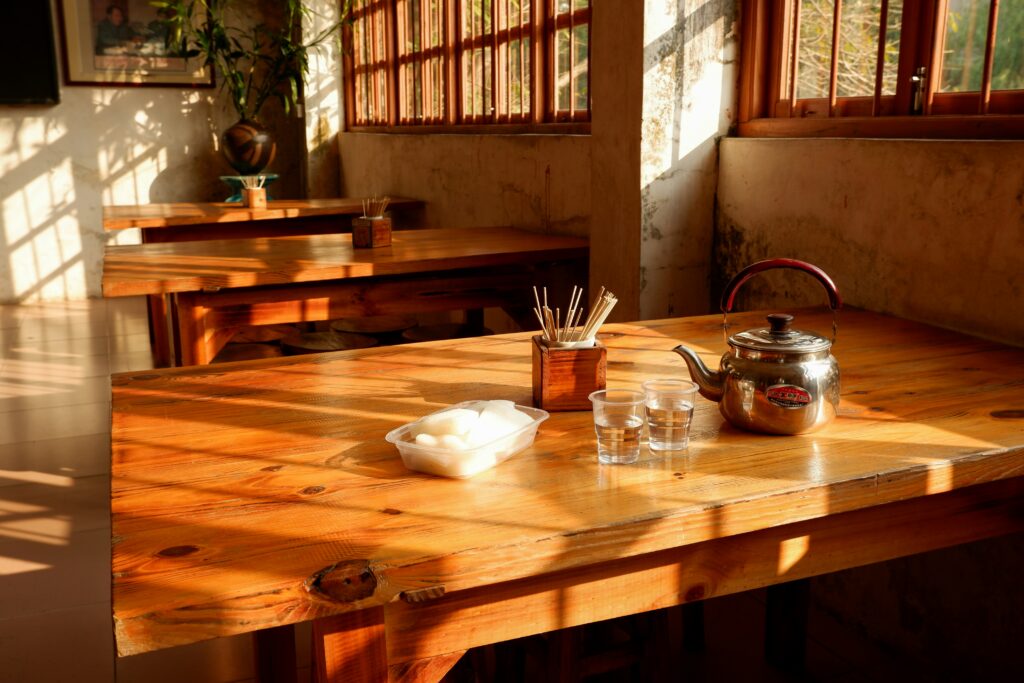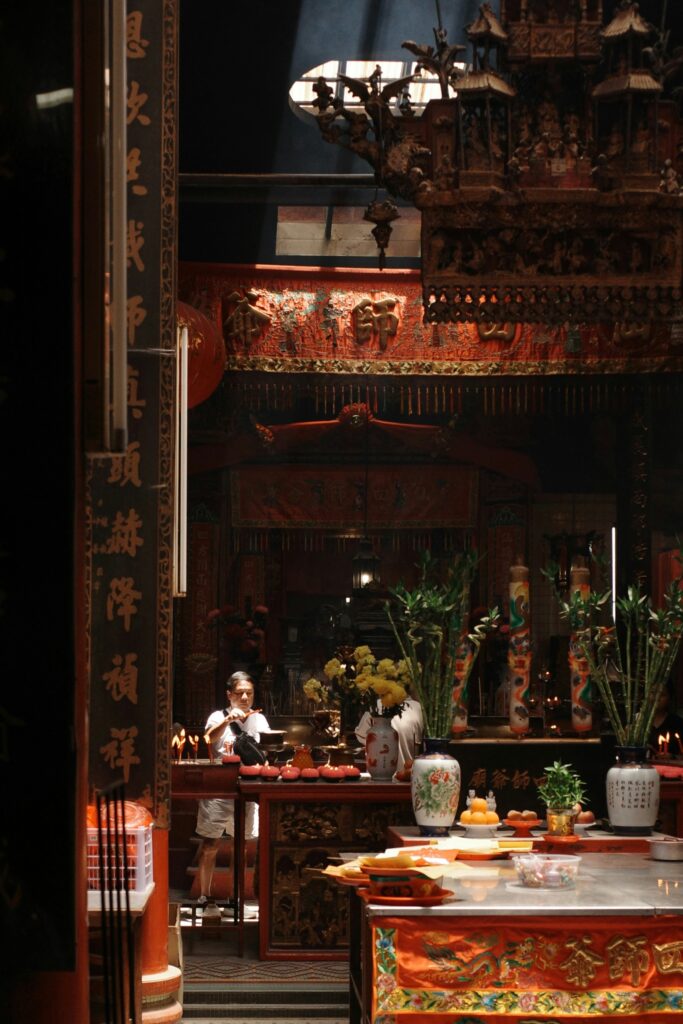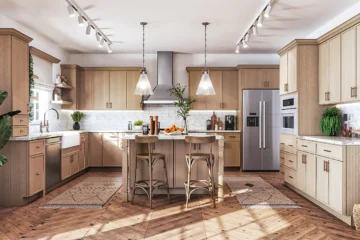
Imagine walking into a kitchen smelling of sesame oil and garlic, with sunlight dancing on warm wood tones and your favorite recipe displayed on a ceramic tile by the stove. That’s the beauty of a Chinese kitchen: it’s a place to live, laugh, and interact, not simply cook.
Generations have gathered around meals here. Stories have been passed down, memories created. When you embrace a traditional Chinese kitchen design, you’re inviting that comfort and lineage into your own home.
1. What Sets a Chinese Kitchen Apart
Purpose in Every Corner
Chinese cooking thrives on high heat—stir-fries, steamers, quick dips in oil. That means grab-and-go tools, burners that roar, and surfaces that clean up fast. Expect:
- Gas burners built for wok cooking
- Large, deep sinks that tackle fresh produce or seafood
- Resilient counters that stand up to prep work
Flow with Intention
Feng Shui isn’t just a buzzword; it’s about intuitive design. Keep fire (stove) and water (sink) separate, let natural light in, and make sure pathways don’t block the flow of energy—or people.
Threads of Culture
Little touches shape the experience:
- Red and gold accents echo tradition and hope
- Carved wood cabinets or lattice panels hint at craftsmanship
- Hand-painted porcelain, scrolls, or family treasures add personality
2. Building Your Authentic Chinese Kitchen

Dedicate a Wok Station
This is where the action happens. A proper Chinese kitchen needs:
- A carbon-steel wok that builds flavor over time
- A high-output burner specifically for wok cooking
- A ventilation system to whisk away aroma and smoke
Choose Wood That Speaks
Your cabinets aren’t just storage—they carry warmth:
- Woods like cherry, walnut, or yellow pine bring depth and texture
- Bronze or brass hardware adds character
- Open shelving helps display beautiful bowls, spice jars, or herbal remedies
Ground with Natural Materials
Stone, wood, and porcelain come together to craft tactile beauty:
- Stone countertops in dark tones feel grounded
- Wood floors or woven bamboo mats bring earthiness
- Ceramic tiles add artisanal charm
3. Honoring Tradition, Embracing Modern Life
You don’t have to break the bank or overhaul everything to adopt a Chinese-inspired kitchen.
- Pair quartz countertops with traditional hardware
- Combine an induction surface for everyday use with your wok burner
- Blend modern cabinetry with classic, rich-toned finishes
This harmony mirrors the Chinese kitchen philosophy: respect the old, but live in the now.
4. Infusing Warmth and Meaning
A Chinese kitchen should feel like an embrace, not a showroom.
- Color palette: terracotta, moss green, charcoal, cream
- Lighting: soft, warm bulbs—think paper lanterns or pendant wood fixtures
- Decor details: a framed family recipe, a clay tea set on gentle display, or seasonal touches like red envelopes during Lunar New Year
These elements carry emotional weight—and make the kitchen feel lived-in.
5. Tools That Matter (and Tell Stories)
Equip your kitchen with tools that earn their place:
- Wok & wok spatula—your culinary team
- Chinese cleaver—perfect for chopping and slicing
- Bamboo steamers for vegetables, buns, or fish
- Rice cooker—efficient, reliable
- Staples at hand: soy sauce, sesame oil, Shaoxing wine, dried spices
These aren’t just utensils. They’re your bridge to authentic taste and tradition.
6. Simple Feng Shui for Everyday Harmony
Bring Feng Shui into your kitchen—even small changes make big differences:
- Keep surfaces clear—energy flows better, cooking feels smoother
- Never put your stove under a window—heat and potential go together
- Mirror the stove’s glow—it symbolically doubles prosperity
- Live plants—especially bamboo or basil—bring freshness and balance
7. Traps to Skip
Stay authentic—without overdoing it:
- Too much decor clutters the space
- Mixing too many styles can confuse your kitchen’s voice
- Reds and golds: use them as accents, not the whole palette
- Aesthetic over function always fails—your kitchen must work for real living
8. Personalized Touches That Speak
The very best kitchens reflect those who cook and live in them:
- Frame an heirloom recipe—your great-grandmother’s signature dish
- Display heirloom bowls and cups passed through the family
- Steep your morning tea in a clay pot crafted decades ago
Your kitchen’s story begins here, with your life and choices.
Conclusion: Where Tradition Meets Your Table
Designing a Chinese kitchen isn’t about copying history—it’s about weaving it into your daily life. Whether you go big or just add a few intentional pieces, you’re crafting a space that feels personal, rooted, and alive.
It’s not just about cooking—it’s about cultivating connection, celebrating culture, and living beautifully every day.
FAQs – Quick Answers
1. Can I adapt this for a small U.S. kitchen?
Yes! Focus on one authentic station, clear shelving, warm tones, and thoughtful accents—weave in tradition without needing lots of space.
2. Is Feng Shui necessary?
Not mandatory, but even small placements—like separating stove and sink—can improve flow and feel in the kitchen.
3. What materials should I prioritize?
Choose natural, timeless options—stone, wood, porcelain, and quality hardware combine beauty with durability.
4. Where to find authentic accessories?
Try local Asian markets, boutique décor shops, or reliable online artisans (look for solid customer reviews).
5. How do I balance tradition with modern living?
Pair traditional accents—like carved handles or rustic finishes—with modern appliances and smart layouts. It’s a gentle blend of past and present.
Related Posts:
White Oak Kitchen Cabinets: Real Homes. Real Reviews
Is Cevurı the Next Big Thing in Mediterranean Cuisine—Or Just a Delicious Mystery?



